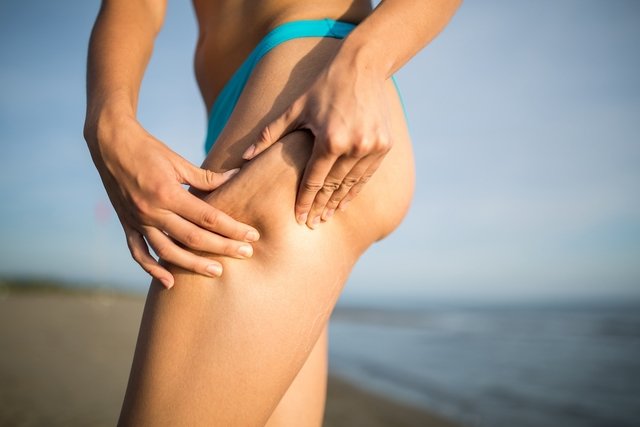Cellulite is the accumulation of fat under the skin, and can be identified by the “orange peel” appearance in which the skin has ripples, especially in areas such as the buttocks, hips, thighs or abdomen.
Cellulite, also known as gynoid lipodystrophy or nodular liposclerosis, can occur due to genetic factors, hormonal changes, unbalanced diet, sedentary lifestyle or being overweight, for example.
Cellulite is not a disease, but it can cause aesthetic and psychological discomfort. In these cases, the treatment recommended by the dermatologist can be carried out, which normally involves changes in diet, lymphatic drainage, radiofrequency or carboxytherapy, for example.

How to identify
Cellulite can be identified by the following characteristics:
- Flabby and uneven-looking skin;
- Skin with the texture of orange peel or walnut shells;
- Holes or small ripples in the skin;
- More visible dimples or depressions in the skin;
- Swellings on the skin with areas of peaks or deep valleys.
In more advanced degrees, cellulite can also present nodules on the skin and cause pain when touched.
Cellulite is more common in women, appearing more frequently on the buttocks, hips, legs, thighs or belly, but it can also occur on the back of the neck or arms, for example.
How to confirm the diagnosis
The diagnosis of cellulite is made by a dermatologist through a physical examination, observing the appearance of the skin.
Make an appointment with a dermatologist in the nearest region:
Taking care of your health has never been easier!
Through this physical examination, the doctor can identify the degree of cellulite and, thus, recommend the most appropriate treatment.
Cellulite degrees
The type of cellulite is classified according to its characteristics into different degrees, which are:
- Grade 1 cellulite: the symptoms are mild and not visible, with the skin having the appearance of an orange peel, only when the affected area is squeezed, compressed or pinched, in which cases you can see the holes in the skin;
- Grade 2 cellulite: symptoms of ripples or holes in the skin can be observed without the need to compress the skin;
- Grade 3 cellulite: you can clearly see the nodules on the skin, which has a walnut-shell appearance;
- Grade 4 cellulite: one can observe the presence of several nodules and swelling on the skin, which appears like a mattress.
Cellulite can also be classified as mild, moderate or severe, which varies according to the number and depth of holes in the skin, changes in the shape of the skin and the degree of sagging, for example.
Is it normal to have cellulite?
Cellulite is a very common dermatological condition that affects around 95% of women, being caused by several factors, genetic, environmental and hormonal, but it is not considered a disease.
However, cellulite can cause aesthetic and even psychological discomfort, and in these cases it is important to consult a dermatologist for an evaluation and recommendation of the most appropriate treatment according to the degree of cellulite.
Possible causes
The exact cause of cellulite is not yet fully known, but it is known that it is formed by an accumulation of fat under the skin, which causes the strings of fibrous tissue to be pulled downwards, forming holes in the skin.
Some factors that can contribute to the development of cellulite, such as:
- Genetic predisposition;
- Gender, being more common in women;
- Natural aging of the body that causes loss of skin elasticity;
- Sedentary lifestyle or frequently sitting or standing for a long time;
- Smoking habit;
- Circulatory problems;
- Diet rich in fats, carbohydrates and/or salt;
- Obesity or overweight;
- Wearing very tight clothes.
Furthermore, hormonal changes, especially estrogen, during adolescence or pregnancy, or the use of contraceptives can also favor the appearance of cellulite.
Other hormones that can also increase the risk of cellulite are insulin, thyroid hormones, norepinephrine or prolactin, for example.
Foods that cause cellulite
Diet can directly influence the development of cellulite, and the main foods that cause cellulite are fried foods, fast food, sausages, ultra-processed foods or excessive use of salt. Check out the complete list of ultra-processed foods.
In addition, alcoholic beverages, coffee, soft drinks, red meat, foods rich in sugar and refined carbohydrates, such as white sugar, white flour, sweets, cookies and crackers, also increase the risk of cellulite.
How the treatment is carried out
Cellulite treatment is not always necessary, however, when it causes aesthetic or psychological discomfort, the dermatologist can recommend some treatments to improve the appearance of the skin.
The main treatments for cellulite are:
1. Lifestyle changes
Lifestyle changes, such as having a balanced, healthy and varied diet, low in sodium, fat and sugar, can help prevent cellulite or prevent it from worsening, especially in people who have a genetic predisposition. See how to get rid of cellulite faster.
Furthermore, it is recommended to drink at least 2 to 3 liters of water per day, avoid smoking and drinking alcohol and exercise regularly. Check out the main exercises to get rid of cellulite.
In the case of people who are overweight or obese, a diet guided by a nutritionist and consultation with an endocrinologist should be followed, who can recommend the best treatment for weight loss.
2. Aesthetic treatments
Aesthetic treatments can be recommended by the dermatologist to help improve the appearance of the skin, and generally involve using anti-cellulite creams, lymphatic drainage, lipocavitation or radiofrequency, for example, which varies according to the degree of cellulite.
Generally, the aesthetic treatment recommended by the doctor must be carried out in association with changes in lifestyle to obtain better results. See all the treatment options to get rid of cellulite.
Home Treatment Options
Some home treatment options for cellulite are drinking some teas, such as green tea or horse chestnut tea, as they help to improve blood circulation or accelerate metabolism and the breakdown of fats, helping to combat cellulite. Find out how to prepare home remedies for cellulite.
However, these teas should be part of lifestyle changes, and should be used with medical advice, as they are contraindicated for children, pregnant or breastfeeding women, or people who have hormonal, digestive or heart problems.

Sign up for our newsletter and stay up to date with exclusive news
that can transform your routine!
Warning: Undefined array key "title" in /home/storelat/public_html/wp-content/plugins/link-whisper-premium/templates/frontend/related-posts.php on line 12
Warning: Undefined array key "title_tag" in /home/storelat/public_html/wp-content/plugins/link-whisper-premium/templates/frontend/related-posts.php on line 13



